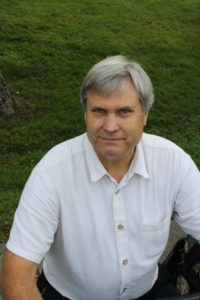When Perry Peterson first set foot in Victoria, he felt at home. A world traveller, Peterson is now teaching engineering at Interurban, but that only takes up about eight hours a week of his time. The rest of his life is dedicated to innovative ways of exploring the Earth through a computer screen.
Peterson’s company, PYXIS Innovation, has built Digital Earth, a virtual globe that allows users to explore the Earth in a whole new way online. What sets it apart from other online maps is that users can zoom in on a specific earthly entity, be it, for example, a tree, a crop, or soil moisture.
“I represent a group of people who want a better world,” says Peterson.

Peterson says that while maps have been around for several millennia and are great for telling people where something is, they’re limited to a text-based, non-immersive experience.
“We’re really trying to do something better, and that is to be able to use the Earth as a way of interfacing all the information that’s out there that’s spatial,” says Peterson. “If we look at our computer screen, there’s a pixelation—single colour in a single pixel and information tied to that pixel. If you look at digital video, it’s done the same way. And so Digital Earth is actually exactly the same. It’s no longer like a latitude and longitude. Any point is the same as any other point. But we partition the Earth into cells, and each cell can contain information about what’s going on in that location.”
Those cells operate on a hierarchy with a parent-child relationship, which allows Peterson’s program to divide the cells up. Through the data in the cells, users can examine the Earth. The more information there is, the more cells there are.
“It’s just a matter of putting tiles over the Earth’s surface and assigning information into those tiles,” says Peterson.
Peterson’s idea has received attention from national media, ending up in Canadian Geographic and The Walrus’ special The Story of Canada in 150 Objects publication. Last year, Peterson took his invention to the United Nations; they adopted his invention, which was a huge step forward for Peterson. He talked to them about what Digital Earth was and how it would benefit humanity. But humanity and community on a smaller scale are also important to Peterson.
“It’s hard,” he says. “You have to commit your life to it and say, ‘This is a small piece that I can contribute,’ and that’s what I always like to tell my students.”
When Peterson first applied for a job at Camosun, he says, the college didn’t reply to his request for an interview, but he remained persistent. Next time he was in Victoria, he visited the college; he says they essentially hired him on the spot when it became clear that he could fill a gap in Camosun’s engineering staff. He says that he chose Camosun because it fit his mentality.
“This is a really innovative college,” he says. “I came from here; I lived here for a couple years when I went to high school, and my mother took courses here.”
He loves what he does, but success comes at a price for Peterson. He flew 75,000 miles last year and spent 58 nights on the road. Peterson deals with a lot of blank looks, shaking heads, and adhesion to old ways when talking to potential investors about his ideas.
“It’s always hard. On a daily basis, it’s hard financially—long hours, a lot of rejection,” he says. “I’ve been humiliated many times. When you’re disruptive—and this is the kind of technology that’s very disruptive—then those that are being disrupted will push back even if they don’t really realize why this disrupts them.”
Peterson finds this aspect of his work difficult; he is after peace, not conflict.
“They’ll want to fight, and I’m not really wanting to fight,” he says. “I would like it to be a better world.”
